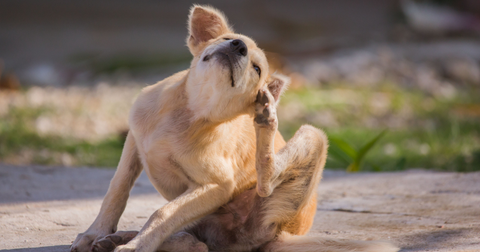Imagine cuddling with your furry friend after a long day, only to spot tiny, unwelcome guests making themselves at home in their coat. The thought of lice can make any pet owner's skin crawl. But when dealing with these pesky parasites, there’s a lot of confusion and misinformation out there.
Can your beloved dog really get lice? And if they do, is it something you need to worry about for your own hair?
Can dogs get lice?
The straightforward answer is yes, your dog can get lice. But there's more to the story than a simple yes or no.
Understanding the type of lice that affect dogs and how they differ from human lice is essential for pet owners.
- Most lice, including the common Trichodectes canis, or chewing louse, feed on the dog's skin and skin debris. They can be vectors for tapeworms, which adds another layer of concern for pet health.
- Linognathus setosus, the sucking louse, feeds on the dog's blood. Sucking lice can cause more severe irritation and potential health issues due to blood loss, especially in severe infestations.
Lice Life Cycle
- Eggs (Nits): Lice eggs, commonly called nits, are laid at the base of a dog’s hair shaft. They are firmly attached to the hair with a glue-like substance and are difficult to remove.
Nits are oval and usually no bigger than a pinhead. They are often a whitish or tan color, making them somewhat challenging to spot against your dog's skin. In about one to two weeks, these eggs hatch into nymphs.
- Nymphs: The nymph is essentially an immature louse that hatches from the nit. It looks like a smaller version of the adult louse.
Nymphs mature into adults about a week after hatching. During this stage, they will begin to feed on your dog’s blood or skin depending on their type (sucking or chewing lice).
- Adults: Adult lice can live up to a month on a dog. In this stage, they continue to feed and, crucially, reproduce.
Females lay a few eggs daily, which stick to the dog's hair and perpetuate the infestation cycle.
Symptoms of Lice Infestation in Dogs
A dog with a lice infestation might exhibit several symptoms that can range from mild to severe, depending on the extent of the infestation:
- Excessive scratching, biting, or licking of the fur
- Dry, scaly, or rough coat
- Hair loss, especially around the ears, neck, shoulders, groin, and rectal areas
- Visible nits (lice eggs) or adult lice in the fur
- Redness or irritation of the skin
- Restlessness and discomfort
How Dogs Can Get Lice
Lice that infest dogs are highly contagious among dogs and can spread in several ways:
- Direct contact with an infested dog
- Sharing grooming tools, bedding, or other accessories with an infested dog
- Contact with contaminated environments such as boarding kennels, dog parks, grooming facilities, or anywhere where dogs congregate.
Lice do not jump or fly; they can only crawl. So physical contact is necessary for their transmission.
Treatment Options for Lice in Dogs

If you suspect your dog has lice, it is crucial to consult with a veterinarian to confirm the diagnosis and discuss treatment options.
Typical treatments may include:
- Topical insecticides: These are applied directly to the dog's skin and can effectively kill adult lice and nits.
- Oral medications: Some systemic treatments can help to kill lice from within.
- Shampoos and powders: Medicated shampoos and powders, such as flea shampoo, can help eradicate lice but often need to be used in conjunction with other treatments.
- Environmental control: Cleaning and treating the dog’s environment is vital to prevent re-infestation.
Prevention is always better than cure. Regular grooming and veterinary check-ups, along with proper hygiene practices, are key in preventing lice infestations in dogs.
Keep in mind that over-the-counter treatments meant for human lice should never be used on dogs, as they can be harmful to your pet.
The Risk to Humans
A common concern among pet owners dealing with a lice infestation in their dogs is the risk of the lice spreading to human members of the household.
The good news is that there is no risk of getting lice from your dog because lice are species-specific. This means that the lice that live and thrive on your pets cannot do the same on humans.
Human lice (Pediculus humanus capitis for head lice, Pediculus humanus corporis for body lice, and Pthirus pubis for pubic lice) have adapted to live on humans and not on dogs or other pets.
- Dog lice (Trichodectes canis and Linognathus setosus) do not find humans to be a suitable environment for survival and reproduction. Their claws are specifically adapted to grasp the hair shafts of dogs, and they cannot hold onto human hair in the same way.
- Human lice require the temperature and humidity found close to the human scalp to thrive (conditions that are not replicated on a dog's body).
Other Pets and Lice

Dogs are not the only pets that can be affected by these parasites. Each species of pet has its own specific lice that have adapted to live on them, much like the situation with dogs and humans.
Cats and Lice
Cats can get lice, though it's quite rare. The species Felicola subrostratus is a louse that specifically targets felines. Much like dog lice, cat lice are host-specific and cannot live on humans. Infestations in cats are less common than in dogs and are usually associated with poor living conditions, neglect, or where the cat's immune system is compromised.
Symptoms of lice in cats are similar to those in dogs and include scratching, a dry coat, and visible nits or adult lice. If you suspect your cat has lice, veterinary treatment will involve topical insecticides or other treatments appropriate for felines.
Small Mammals and Birds
Other pets, such as rabbits, guinea pigs, and birds, can also be afflicted by their own species-specific lice.
These are typically host-specific as well and do not pose a threat to humans.
- Rabbits and guinea pigs: These small mammals can get lice, with signs including scratching, hair loss, and restlessness. Treatment involves topical insecticides that are safe for use on these smaller animals.
- Birds: Lice on birds are a bit different, as they tend to feed on feathers rather than skin. Infestations can lead to feather damage, itching, and restlessness. Treatment involves the use of powders or sprays formulated for avian use.
The transmission of lice between different species of pets within the same household is highly unlikely due to the host-specific nature of these parasites.
Lice have evolved over time to specialize in living on certain hosts, and they are not equipped to survive on a different species. This host specificity is good news for pet owners with a multi-species household, as it limits the spread of infestations.
Preventing Lice in Pets
Prevention of lice in pets is critical not only to maintain the health and comfort of the animals but also to ensure the infestation does not spread or recur.
Here are some effective strategies for preventing lice in pets.
- Regular Grooming: Frequent brushing, baths, and the use of a flea comb can help you spot and remove any signs of living or dead lice early before they become a larger issue.
- Veterinary Check-ups: Annual or bi-annual vet visits are essential for early detection of lice and other health issues.
- Proper Pet Hygiene: Wash pet bedding, toys, and accessories regularly to eliminate any lice or nits that may be present.
- Avoid Contact With Infested Animals: Keep your pets away from others who are known to be infested with lice.
- Parasite Prevention Products: Consult with your veterinarian about preventive products that can be used to ward off lice and other parasites.
Keeping the Itch at Bay

If your dog does get lice, it's not a crisis, and won’t affect humans in your household. With professional guidance and diligent cleaning, you can defeat the infestation.
Always rely on your vet for accurate information and avoid getting swayed by common misconceptions about lice transmission.




Comments (0)
There are no comments for this article. Be the first one to leave a message!